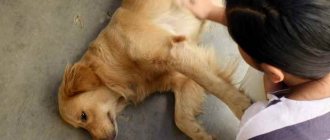The main causes of bloating in dogs
The digestive system of carnivores, including domestic dogs, is not genetically adapted to consume large amounts of carbohydrate food. In this regard, violation of the principle of rational nutrition of a pet is the main reason for increased gas formation. If household members pamper the dog with sweets and foods related to the so-called “fast” carbohydrates, then sooner or later bloating occurs.
Carbohydrate foods cause the body to spend more time digesting them than breaking down protein ingredients. This disorder is accompanied by the accumulation of bacteria, the main food of which is monosaccharides. This leads to the formation of large amounts of gas in the stomach and intestinal tube.
Foods that cause bloating and increased gas formation include, first of all, sweets, flour and bakery products, as well as vegetables such as cabbage and legumes. Dairy products, especially whole milk, can also cause fermentation in the intestines. When feeding your pet fresh fruits, you should also be aware that many of them (apples, pears, grapes, peaches) cause bloating.
A sudden transition from one food to another can also provoke a problem. The body does not have time to adapt; a failure in the production of digestive enzymes leads to increased gas formation.
Experienced dog breeders and breeders note that the disease can manifest itself in a four-legged pet if the owner carries out active training immediately after feeding. Exercising after eating can lead to increased gas production due to impaired digestive function.
Unplanned pregnancy
A bitch's swollen, tight belly, when the sides extend beyond its limits, may indicate pregnancy. If fertilization after mating with a male dog is an expected event for the dog owner, then an unplanned conception comes as a complete surprise. A pet can become pregnant during a walk, if the owner leaves her unattended for a long time or she has free access to the street, or during sexual contact with a mature male living with her in the same territory.
A large belly in a bitch is a sign of pregnancy if there are other symptoms associated with this condition:
- decreased appetite;
- behavior change;
- redness and swelling of the nipples;
- nausea or vomiting.
Pregnancy in a dog does not require any measures to be taken at home. To make sure that gestation proceeds without complications, it is recommended to show your pet to a veterinarian.
Accumulation of gases (flatulence)
If your dog has a bloated stomach and frequent passing of gas, he most likely suffers from flatulence. There can be many reasons for increased gas formation - from poor diet to intestinal blockage. Often the animal has signs of concomitant diseases: vomiting, diarrhea, refusal to eat, increased body temperature, etc.
If there is excessive formation of gases, it is necessary to find out what exactly led to this condition. Increasing the load, such as active jogging, will help remove them from the intestines at home. However, this method is used only if the dog has no other symptoms. It is also recommended to give your pet a medicine that absorbs gases and reduces their formation:
- Activated carbon;
- Simethicone, Espumisan;
- magnesia;
- Smecta et al.
These measures will only eliminate the external manifestations of the problem. Finding out the root cause of flatulence should be entrusted to a veterinarian.
Fluid accumulation
Bloating in your dog's abdomen may be evidence of fluid accumulation in the abdominal cavity. This phenomenon, which in veterinary medicine is called ascites, is dangerous to the pet’s health and requires immediate action. Sometimes the dog’s life depends on how quickly the dog’s owner reacts to a situation. Fluid can accumulate due to problems with the liver and heart, as well as injuries.
If, in addition to an enlarged abdomen, the dog breathes heavily, drinks a lot and goes to the toilet often, moves little, eats poorly, vomits, and the mucous membranes turn blue, most likely we are talking about ascites. It is not recommended to try to treat this disease on your own. It is better, without wasting time, to take your pet to the veterinary clinic.
Worm infestation
If your animal has a bloated belly, this may be due to the presence of parasites in its intestines. A helminthic infestation can be recognized by the following signs:
- loss of appetite and weight loss;
- deterioration of coat condition;
- shortness of breath, cough;
- constipation alternating with diarrhea;
- vomit;
- skin rashes.
If these symptoms are present, the dog needs to be treated for worms. Subsequently, deworming should be carried out every 3 months.
Disease of the gastrointestinal tract
Flatulence occurs as a result of disruption of the digestive system. The dog may experience intestinal blockage and its peristalsis may be disrupted. A lack of enzymes and an excess of harmful bacteria over beneficial ones also lead to increased formation of gases.
If there are diseases that require drug treatment, the dog has no appetite, becomes lethargic, and practically does not move. The temperature often rises to 39 degrees.
What to do if your dog’s stomach is swollen and alarming symptoms appear, the veterinarian will tell you. The doctor will need to examine the animal and take tests if necessary.
Other Possible Causes
The dog is suspected to have a cold. In addition to loss of appetite and thirst, the following symptoms are recognized:
- increased body temperature (a temperature of 37.0 - 39.0 degrees Celsius is considered normal);
- hot and dry nose;
- enlarged lymph nodes;
- discharge from the eyes;
- cough;
- frequent and intermittent breathing during physical activity;
- shortness of breath at rest;
- nasal discharge;
- absence of “barking” or a hoarse and rough voice that turns into a cough.
A cold is diagnosed not so much by external signs, but by a blood test, listening to the dog’s heart and lungs, and taking smears from the mucous membranes. Performed by a doctor. Owners are advised to minimize walks with their pet, limit contact with animals and ensure comfort.
Causes in dogs may include congenital heart disease, various respiratory diseases, and exposure to certain chemicals that lead to the creation of abnormal forms of hemoglobin that are unable to properly bind oxygen.
There are two main types of cyanosis: central and peripheral.
- Central cyanosis is the result of malfunction of the entire central circulatory system and is caused by a decrease in oxygen levels in the entire circulatory system. All tissues are damaged.
- Peripheral cyanosis occurs in a specific area of the body. Its causes may be hypothermia (low body temperature leads to constriction of blood vessels in the skin); thromboembolism (blood clot that interferes with normal blood flow); use of a tourniquet (accidental, intentional or harmful); shock (insufficient blood flow to tissues).
All animals with central cyanosis also have peripheral cyanosis, because All the blood is not saturated with oxygen. However, there may be peripheral cyanosis without central cyanosis.
In young animals, the most likely cause of central cyanosis is a congenital heart defect, in which the blood partially bypasses the lungs and is not saturated with oxygen due to anatomical disorders in the structure of the heart and blood vessels (tetralogy of Fallot, ventricular and atrial septal defects, patent ductus bollus).
Animals of any age can develop secondary cyanosis due to pulmonary disease (severe pneumonia) or factors that prevent normal expansion of the lungs (fluid or air in the chest cavity). Cyanosis can also be caused by laryngeal paralysis, airway obstruction, diaphragmatic hernia, neurological disorders, pulmonary hypoventilation, respiratory muscle insufficiency, pulmonary embolism, pulmonary edema, acute respiratory distress syndrome, pulmonary fibrosis, neoplasia.
Genetic defects can affect hemoglobin's ability to carry oxygen. However, this defect rarely occurs in animals. Hemoglobin defects are more associated with food intoxication, or exposure to chemicals and oxidizing agents (such as nitrates, nitrites, acetaminophen, etc.).
Cyanosis in dogs is a clinical symptom, and if it occurs, you should immediately take your dog to the veterinarian.
Severe bloating and gas formation
In addition to problems with feeding, more serious reasons can lead to an increase in abdominal volume in four-legged pets. Thus, according to veterinary specialists, acute bloating in the abdominal cavity can be caused by ascites, in which pathological accumulation of fluid occurs in the peritoneum. Dropsy is not an independent disease, but indicates poor circulation, cardiac disease, kidney problems, etc.
Such a severe pathology as peritonitis also leads to sudden bloating. As a result of purulent inflammation of the peritoneum, it is filled with exudate, blood, and lymph. The condition is life-threatening for the animal and requires immediate qualified assistance.
One of the reasons that an owner observes a sudden enlargement of a dog's abdominal cavity is pyometra. Purulent inflammation of the uterus is accompanied by the release of an increased amount of gases. Clinically, the owner observes a sharp bloating of the dog’s abdomen with this dangerous disease.
Numerous helminthiases can lead to acute expansion of the stomach and intestines. Parasites disrupt the production of digestive enzymes, leading to a failure of the absorption capacity of the small intestine, which is accompanied by increased gas formation.
One of the life-threatening causes of a sudden increase in the size of the abdomen is a volvulus of the stomach or a rupture of the wall of the organ. This condition is most often diagnosed by veterinarians in representatives of large breeds. As a result of the rapid filling of the hollow organ with gases, its strong expansion occurs. The enlarged stomach puts pressure through the diaphragm on the heart muscle, which in some cases leads to sudden death in giant breeds.
Considering the seriousness of the reasons leading to bloating, the owner must be able to recognize in which situation it is all about increased gas formation due to foods, and in which condition it can threaten the health and life of a four-legged friend.
Causes of spasms in dogs
Inflammation of the peritoneum occurs as a result of infectious diseases, gastric resection, mechanical damage, as well as the appearance of inflammatory processes in neighboring organs. The disease can be chronic or acute, both in a specific area and throughout the entire peritoneum.
The nature of the inflammation can be dry or purulent. In addition to the symptoms of stomach cramps, the dog’s body temperature rises, the stomach becomes enlarged due to putrefactive processes and the formation of gases. , depressed, refuses to take food, her. Vomiting is sometimes observed.
Treatment
- The dog must be placed in a warm room,
- Apply cold compresses first, and later warm ones.
- A diuretic can be given, but antibiotic treatment is also necessary.
- Sometimes surgery is necessary.
Worms and gastric volvulus are some of the causes of spasms in dogs.
The most terrible cause of spasm. Without immediate assistance from a surgeon, the animal dies. Symptoms of this disease are a sharp increase in the dog’s abdomen, heavy breathing, weakness, vomiting foam, pallor of the mucous membranes, and loss of consciousness. Volvulus can only be diagnosed using probing and x-rays.
Therefore, with such symptoms, it is necessary to urgently call an ambulance or transport the animal to a veterinary clinic, where he will undergo abdominal surgery: the stomach will be untwisted and sutured to the abdominal wall. Volvulus most often occurs in dogs of large and medium breeds. Its causes are one-time heavy feeding, games or stress immediately after eating, gastrointestinal diseases (gastritis, ulcers, gastroesteritis), poorly digestible feed.
Even experienced dog breeders often encounter dog health problems that baffle them, for example, sometimes the dog has abdominal cramps that are not always possible to recognize. The fact is that the animal cannot explain the essence of the problem, and even in those situations when you manage to determine the location of pain, it is quite difficult to understand the cause and nature of the pain. In such situations, you must immediately make an appointment with a veterinarian. This material has been prepared for informational purposes, and the problem that will now be discussed is precisely cramps in the abdominal area.
The main symptoms of bloat in a dog
The pathological condition begins suddenly, causing pain to the dog, or proceeds unnoticed by it and the owner. Depending on the symptoms accompanying bloating, acute and chronic stages are distinguished.
Chronic form
Most veterinarians agree that pets’ digestion is disrupted when dry food is incorrectly selected or the dog eats from the common table. It is because of an unbalanced diet that chronic bloating develops. The animal is practically not worried and behaves as usual. But if measures are not taken, such a condition is fraught with malfunctions of the pancreas and liver.
Acute form
There are times when a dog’s health deteriorates sharply. Suddenly her stomach swells, she begins to whine, and becomes overly anxious. The pet can tuck its back paw if it really hurts.
Other symptoms observed:
- The dog is bothered by belching and hiccups.
- Vomiting begins with foam and an unpleasant odor.
- Diarrhea appears. In any case, the number of bowel movements increases and mucus and sometimes blood are noticeable in the stool.
- Appetite decreases or disappears completely.
- The mucous membranes acquire a bluish tint.
- Breathing changes, sometimes shortness of breath occurs.
If a dog's stomach is swollen, then its limbs may fail and its eyes may bulge. Don't wait until all the warning signs appear. If you observe at least one additional sign, if the stomach begins to swell, you need to go to the veterinary clinic. This condition can cause gastric volvulus. In rare cases, its wall ruptures. If you do not provide help to your pet in a timely manner, it may die.
The dog will be accurately diagnosed after examination. You will need to take an x-ray of the abdominal cavity, take stool and blood for analysis.
What is fever in dogs? Pet is hot to the touch
The normal body temperature for dogs is between 38 and 39.0 degrees Celsius, which is higher than that of humans. This means that your dog may be hot to the touch, even if his temperature is completely normal. There is also a temperature limit from 39 to 39.5 degrees, when it is impossible to reliably estimate the temperature. Within this limit, it can be normal or increased. Therefore, you need to pay attention to additional symptoms - activity and appetite. In rare cases, temperatures of 40 and above occur in healthy dogs after intense exercise or stress. After resting and calming down, you need to measure your temperature (after 30 minutes).
Recommended reading: Smelly pug urine
The word fever is commonly used to describe increased body temperature caused by infection or inflammation. A temperature exceeding 39.5 degrees is considered elevated, although it can also be 40 if the dog is very excited or under stress. You need to let it breathe and re-measure after 30 minutes. If the temperature drops, everything is fine; if not, you need to show your pet to the veterinarian.
When dogs have a high fever, which is the result of heat or excessive exercise in humid conditions, the condition is called hyperthermia or heatstroke. When the temperature reaches 40.5 degrees, serious and fatal complications can occur.
Diagnostics
How to understand why a dog's stomach is swollen? If the owner regularly carries out deworming, the animal is sterilized or is regularly taken for mating, then at least 2 reasons can be excluded. Symptoms of normal bloating during flatulence are as follows:
- swollen belly, taut like a drum;
- the dog whines, moans, is restless, does not find a place;
- the urge to vomit after 5-30 minutes, sometimes looking like a frequent cough;
- weakness, shortness of breath;
- cardiopalmus;
- frequent attempts to defecate, but without success;
- attempts to eat pebbles and hard objects.
The listed external signs can be symptoms of many diseases. The swelling may go away naturally, but if the situation does not improve, you should urgently take the dog to the doctor. The stomach, stretching, displaces the ligaments that attach the internal organs. With sudden movements: jumping from the sofa, running, a displacement of the intestines and stomach can occur, which is fraught with serious consequences. Pyometra can also be diagnosed by examining the genitals. It is not possible to independently determine ascites and peritonitis at home. If the animal looks depressed, lies around a lot, loses interest in food, vomits, and at the same time has an enlarged peritoneum, you should immediately take it to a veterinary clinic for examination to reduce the risk of death.
Possible diseases
Having noticed that the dog’s mucous membranes are not a normal pale pink shade, the owner should carefully examine the pet and take him to the veterinary clinic.
In a veterinary hospital inpatient setting, the animal will undergo all the necessary diagnostic measures and determine the cause that caused the pallor of the mucous membranes. Both physiological and pathological factors can provoke a change in the shade of the mucous membranes.
Dangerous pathologies include foreign objects stuck in the throat or tumors blocking the respiratory tract. An equally dangerous pathological factor that can cause pale mucous membranes is internal hemorrhages.
It is important to remember that most diseases, one of the signs of which is pale gums in a dog, are extremely dangerous and threaten the life of the animal. In the overwhelming majority, anemia of the mucous membranes indicates an acute lack of oxygen in the body, associated with a decrease in iron-containing protein, blood loss, and heart muscle failure.
If the animal has been hit by a car and, among other problems, pale gums are noted, it is necessary to take the dog to the clinic as soon as possible. This pallor of the mucous membranes is associated with internal serious injuries and hemorrhages. In addition, pneumothorax can cause pallor.
At home, it is not possible to establish the exact cause of disorders in the body and the associated change in the color of the mucous membranes.
It is necessary to contact a veterinary clinic for help as soon as possible. As a last resort, you can consult with a doctor online by phone or via the Internet. This will make it possible to assess risks and chances.
Sometimes pale gums are diagnosed in dogs with severe hypothermia. In order to warm the animal, it is necessary to wrap it in a warm blanket and take it away from the source of the cold. You can use warm water bottles instead of heating pads. If the animal is in a state of shock, which can also cause pale mucous membranes, it is necessary to calm the pet.
If you suspect a serious injury to a dog, it is not advisable to touch the pet’s body. You must try to fix the animal’s body in one position and wait for the veterinary specialist to arrive. Special transport to a veterinary clinic may be required.
Dog and cat owners are mostly apartment owners and are constantly busy at work. It’s rare that an owner has time for a normal walk with a pet, not to mention outdoor games.
Some leave the dog to neighbors so that they can walk the animal when necessary. Lack of time for your pet affects its condition. The owner would rather self-medicate in order to save time than go to a veterinary clinic. However, only in the conditions of a veterinary hospital, a specialist will be able to draw blood for further study, ultrasound examination of internal organs and other instrumental studies.
Treatment at home is advisable only if the veterinarian has carried out a thorough diagnosis and no pathological conditions that threaten the animal’s life have been identified.
Do you want to know more about the article or something? Call +79774692712, we will advise you.
Source
Treatments for bloating
There is no universal way to treat bloating; any veterinarian prescribes a series of tests for the animal before starting to act. The only thing that precedes a dog's examination is surgery to clean out the abdominal cavity.
Passing the operation
In general terms, a surgical intervention to cleanse a dog’s stomach of excess fluid includes several main steps:
- the animal is given intravenous anesthesia;
- the surgeon opens the abdominal cavity and inserts a special probe to pump out the exudate;
- after removing excess fluid, the surgeon performs gastropexy, that is, attaches the stomach to the peritoneal wall or to the diaphragm to avoid relapses;
- Next, the abdominal cavity is sutured, and the animal is given a drip so that it recovers faster after the operation.
The operation allows you to remove fluid from the abdominal cavity and secure the stomach to avoid relapses
Dog's diet after surgery
After the operation, the pet is prescribed a special diet designed to prevent possible deterioration of the condition:
- Feeding only ground food is allowed. In the first days, the dog eats mostly boiled rice, gradually adding small amounts of ground meat;
- Portions must be strictly dosed. At one time, the dog should consume no more than 120 milliliters of these products, and the animal should be fed every hour;
- any fermented milk or dairy products, despite their lightness and usefulness, should be completely excluded from the diet during recovery.
Cooked rice is the best food for a dog recovering from surgery.
Treatment of helminthic infestation
The treatment for this disease, as you might guess, consists of undergoing deworming, which the dog owner forgot about before. However, before giving your pet a certain anthelmintic drug, you need to consult a veterinarian, since not every medication may be suitable for your pet.
There are different types of worms, and therefore different types of treatment. If you choose the wrong remedy, you risk only aggravating the animal’s condition. To avoid such negative consequences, the veterinarian must prescribe a stool test for the dog.
Drugs that have shown their effectiveness on adults are listed in the table below.
Table. Anthelmintic drugs for dogs
Drug Dosage
| "Dironet" | 1 tablet per 10 kilograms of animal weight; 1 milliliter of suspension per 1 kilogram of animal weight |
| "Panacur granulate" | 50 milligrams of substance per 1 kilogram of animal weight |
| "Prasicide" | 1 tablet (500 milligrams) per 10 kilograms of animal weight |
| "Pratel" | A quarter tablet for dogs weighing up to 2 kilograms; half tablet for dogs weighing up to 5 kilograms; tablet for dogs weighing up to 10 kilograms; 2 tablets for dogs weighing up to 20 kilograms; 3 tablets for dogs weighing up to 30 kilograms |
| "Azinox" | 1 tablet per 10 milligrams of animal weight |
The release form of anthelmintics is different. There are preparations in the form of suspensions (often intended for puppies), in the form of tablets, drops that are applied to the dog’s withers, and so on. All anthelmintics require an individual dose calculation based on the animal’s body weight.
Treatment of pyometra
Treatment methods for pyometra again depend on its form. Closed pyometra involves surgery to remove the uterus and ovaries. This method is considered radical, but the only one that allows you to save the dog’s life. Treatment of the open form of pyometra is carried out conservatively and includes the use of antibiotics, hormonal drugs and other medications that the veterinarian will prescribe after a detailed examination of the animal.
To prevent this serious disease, owners are advised to periodically check the hormone levels of their pets (especially if we are talking about mature animals). When elevated progesterone levels are already known, the veterinarian prescribes special medications to reduce it.
Treatment of peritonitis
Regardless of what causes the peritonitis, the first thing the veterinarian does is remove excess fluid from the peritoneum and put the dog on a starvation diet so as not to provoke a relapse. If peritonitis was preceded by perforation of the intestine or stomach, then the pet must undergo a laparotomy.
After surgery, dogs are prescribed a course of antibiotics.
Does postoperative treatment include the use of antibiotics to prevent the occurrence of foci of infection in a weakened body? and painkillers, allowing the dog to recover from attacks of pain. In addition to these drugs? drugs that improve heart function and other general health-improving medications are often prescribed.
Treatment of ascites
Since abdominal dropsy is a consequence of other serious disorders in the animal’s body, any treatment must begin with a thorough diagnosis. Of course, even before the examination begins, it is necessary to remove all excess fluid from the pet’s abdominal cavity to give him the opportunity to recover. It should be noted that a single removal of liquid in itself is completely useless. In the absence of comprehensive treatment, previous pathologies will again make themselves felt and again lead to ascites, which will be even more difficult to experience.
In most cases, one of the following drugs is prescribed for ascites:
- "Veroshpiron";
- "Furosemide";
- "Temisal";
- "Eufillin."
All of the medications listed are diuretics and promote the rapid removal of excess fluid from the body. It is necessary to give your dog such medications strictly in the prescribed doses, otherwise the animal’s electrolyte balance may be disrupted, as a result of which the pet will lose a large amount of useful substances.
Prevention
If your pet is prone to bloating and other stomach problems, you need to provide him with the right lifestyle. Adhere to the following rules:
- Walk your dog at least once a day.
- If you have already had problems with bloating, purchase medications for gas formation and those medications prescribed by your veterinarian. Always have them on hand.
- Do not overfeed your dog, even if it begs for it. An adult dog needs 3 meals a day, a puppy – 4-5.
- Feed your dog after a walk.
- To prevent air from entering the stomach, do not give the animal water immediately after a walk. The dog should also not consume liquid before eating.
- Include about 30% meat and other foods containing fiber in your natural diet.
- Purchase special herbs intended for dogs at a pet store.
- Choose food that contains a minimum amount of grains and carbohydrates.
- If you are switching your dog from one food to another, do it gradually.
- Allow the animal to eat food slowly and calmly.
- Keep your pet away from all situations that may cause stress.
How to properly feed a dog after bloating?
During the first 12 hours after fixing a dangerous condition, you should not give your pet food. After this, you can switch him to a light diet food. The pet owner should adhere to the following general rules:
- Completely exclude fermented milk products from the menu until the animal fully recovers. The fact is that they can easily provoke repeated bloating, which will not be easy to eliminate. Such food is especially dangerous for animals that have recently undergone surgery.
- Strictly follow the recommended serving size for your pet. You need to feed him every hour. As you recover, the intervals between meals can be increased. This issue should be supervised by a veterinarian.
- Give your pet finely chopped food. In the first days of treatment, the basis of the diet can be boiled rice with a small addition of meat. Gradually, other products can be introduced into the menu. This diet is suitable for pets who have recently undergone surgery.
- If possible, it is better to switch your dog to ready-made premium food that does not contain prohibited products and still contains many nutrients. After your pet has fully recovered, you can easily switch him to a regular formula or natural food.
Since bloating can be associated with various dangerous pathologies, it is recommended that a veterinarian select food for a sick pet. He must do this taking into account the characteristics of the breed, existing diseases, age and weight of the dog. In this case, the doctor’s recommendations must be strictly followed.











